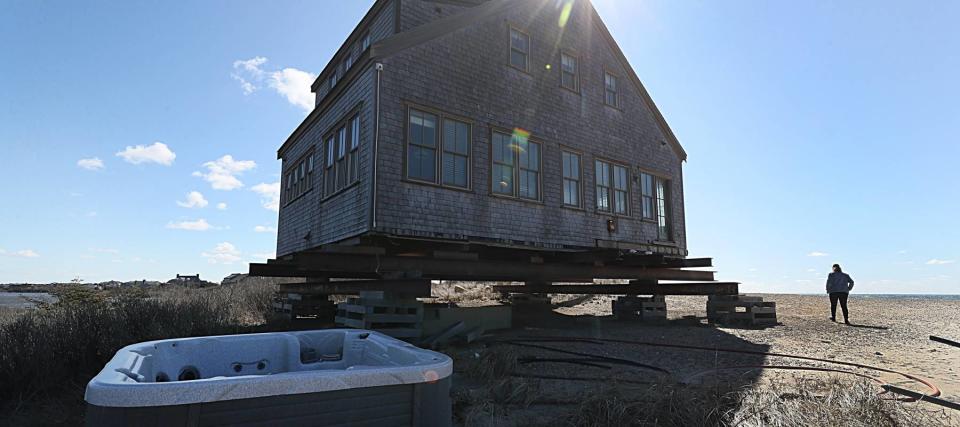America's elite keep buying pricey homes in Nantucket — even though properties are sinking into the ocean

Real estate investor Barry Sternlicht had his million-dollar Nantucket beach house demolished in April due to rising sea levels. All that remained from the wreckage was some wood, a dumpster and an empty hot tub, according to the Nantucket Current.
The three-bedroom home was previously sitting on steel girders, as Sternlicht waited for an opportunity to move it inland. But years of storms claimed even more of the coast, and he was forced to destroy the property.
Don't miss
Cost-of-living in America is still out of control — use these 3 'real assets' to protect your wealth today, no matter what the US Fed does or says
Car insurance rates have spiked in the US to a stunning $2,150/year — but you can be smarter than that. Here's how you can save yourself as much as $820 annually in minutes (it's 100% free)
These 5 magic money moves will boost you up America's net worth ladder in 2024 — and you can complete each step within minutes. Here's how
Erosion has caused several homes along the Massachusetts island’s coast to plummet into the ocean, however, that hasn’t deterred demand from America’s elite, who flock to its dune-backed beaches in hordes each year.
"The concentration of wealth is quite stunning on Nantucket, and it keeps escalating," Bruce Percelay, a real estate developer, told Business Insider.
"To use a well-worn phrase, come hell or high water, people are still buying multimillion-dollar homes on Nantucket."
'Leases with Mother Nature'
Nantucket’s housing problems are only expected to worsen in the future.
Over the next half-century, rising sea levels, coastal flooding and erosion are expected to cause over $3.4 billion in damage across the island, according to the local government’s 2021 Nantucket Coastal Resilience Plan. By 2070, over 2,300 buildings — of which, 84% are residential — will be at risk of coastal flooding or erosion.
But this hasn’t caused demand for housing to deteriorate. The median home sale price last year was a stunning $3.2 million, up from $1.9 million just five years prior, according to data from local company [Fisher Real Estate](https://80925.fs1.hubspotusercontent-na1.net/hubfs/80925/FisherYearInReview_2023-4.pdf]. The firm also reported over a quarter of homes sold for over $5 million in 2023.
Read more: Thanks to Jeff Bezos, you can now use $100 to cash in on prime real estate — without the headache of being a landlord. Here's how
And some buyers are even purchasing properties that are mere years away from sinking into the ocean. Real estate agent Greg Mckechnie told Business Insider: "Those are properties we refer to occasionally as leases with Mother Nature."
While a few sellers are slashing their listing prices, some of the more picturesque areas have seen homes increase in value.
"When it comes to rising sea levels, the trade-off for the amenities, location and often views, people are willing to take on the mitigation that needs to be done," Mckechnie said. This could mean doing some home improvement work, like adding storm panels, or building at a higher level.
There are expensive — and complicated — solutions
Some Nantucket homeowners are shelling out a small fortune to move their homes away from the coast, while others, like Sternlicht, are faced with no other option than to raze them down entirely.
Sternlicht originally planned to relocate his Cisco Beach home until Hurricanes Paulette and Teddy left him with no more space to move the property.
And one group of homeowners on Baxter Road embarked on a controversial project, installing “geotubes” — massive, cylindrical bags of sand designed to control erosion — along 900 feet of the shoreline, according to The New York Times.
The idea was conceived after a storm in 2013, and has cost residents an estimated $10 million to maintain over the years.
"It's not inexpensive, but it is worth doing," Baxter Road resident and housing developer Joshua Posner told the Times. "It's like another tax bill."
However, local groups have been fighting back and forth over the years over the long-term viability of the geotubes, which at one point were scheduled to be removed. The Conservation Commission, a regulatory board responsible for protecting wetland resource areas, has argued that engineered structures, including geotubes, can disrupt a beach’s natural behaviors and cause erosion to increase elsewhere, according to the Times.
What to read next
Car insurance premiums in America are through the roof — and only getting worse. But 5 minutes could have you paying as little as $29/month
‘Baby boomers bust': Robert Kiyosaki warns that older Americans will get crushed in the 'biggest bubble in history' — 3 shockproof assets for instant insurance now
Who says you can’t beat the market consistently? Meet the team of market experts whose stock picks outperformed the S&P 500 by 12% — four years running
This article provides information only and should not be construed as advice. It is provided without warranty of any kind.

 Yahoo Finance
Yahoo Finance 